2020-09-18 • Clip spikes before STA
Contents
2020-09-18 • Clip spikes before STA¶
This notebook is similar to /notebooks/2020-07-29__STA and /notebooks/2020-09-10__STA_for_different_PSP_shapes.\
We still wonder whether the bump in the STA is due to averaging post synaptic potentials (PSPs), or postsynaptic spikes.
Here, we try to remove the influence of spikes in the STA by clipping them before averaging windows.
Reproducibility¶
%reload_ext watermark
%watermark -ntz -v -hm -rgb -iv
Fri Sep 18 2020 16:08:54 GMT Daylight Time
CPython 3.8.3
IPython 7.13.0
compiler : MSC v.1916 64 bit (AMD64)
system : Windows
release : 10
machine : AMD64
processor : Intel64 Family 6 Model 142 Stepping 9, GenuineIntel
CPU cores : 4
interpreter: 64bit
host name : LABTOP
Git hash : 5c2958efe77ec99f89399e38845283c44798eadc
Git repo : git@github.com:tfiers/voltage-to-wiring-sim.git
Git branch : main
Nothing new here¶
All sections nested under this are the same as in the two previous notebooks.
Imports & time grid¶
from voltage_to_wiring_sim.notebook_init import *
Preloading:
- numpy … (0.20 s)
- matplotlib.pyplot … (0.35 s)
- numba … (0.68 s)
- sympy … (0.89 s)
- unyt … (3.99 s)
Imported `np`, `mpl`, `plt
Imported package `voltage_to_wiring_sim` as `v`
Imported `*` from `v.util` and from `v.units`
Setup autoreload
Reproducibility info. This notebook was last run on/with:
Fri Sep 18 2020 16:09:01 GMT Daylight Time
CPython 3.8.3
IPython 7.13.0
compiler : MSC v.1916 64 bit (AMD64)
system : Windows
release : 10
machine : AMD64
processor : Intel64 Family 6 Model 142 Stepping 9, GenuineIntel
CPU cores : 4
interpreter: 64bit
host name : LABTOP
Git hash : 5c2958efe77ec99f89399e38845283c44798eadc
Git repo : git@github.com:tfiers/voltage-to-wiring-sim.git
Git branch : main
tg = v.TimeGrid(T=10 * minute, dt=0.1 * ms)
TimeGrid(T=Quantity(10 min, stored in s, float64), dt=Quantity(0.1 ms, stored in s, float64), N=unyt_quantity(6000000, '(dimensionless)'), t=Array([0 1.667E-06 3.333E-06 ... 10 10 10] min, stored in s, float64))
Spike trains¶
‘Network’ definition.
N_in = 30
p_connected = 0.5
N_connected = round(N_in * p_connected)
N_unconnected = N_in - N_connected
15
Have all incoming neurons spike with the same mean frequency, for now.
f_spike = 20 * Hz
Quantity(20 Hz, stored in Hz, float64)
gen_st = v.generate_Poisson_spike_train
fix_rng_seed()
%%time
spike_trains_connected = [gen_st(tg, f_spike) for _ in range(N_connected)]
spike_trains_unconnected = [gen_st(tg, f_spike) for _ in range(N_unconnected)]
Wall time: 5.26 s
all_spike_trains = spike_trains_connected + spike_trains_unconnected;
Inspect a time excerpt..
time_slice = 1 * minute + [0, 1] * second
slice_indices = np.round(time_slice / tg.dt).astype(int)
i_slice = slice(*slice_indices)
t_slice = tg.t[i_slice].in_units(second);
..of one presynaptic neuron:
v.spike_train.plot(t_slice, all_spike_trains[0][i_slice]);

All connected presynaptic neurons:
all_incoming_spikes = sum(spike_trains_connected)
v.spike_train.plot(t_slice, all_incoming_spikes[i_slice]);

Synaptic conductance¶
Δg_syn = 0.8 * nS
τ_syn = 7 * ms;
g_syn = v.calc_synaptic_conductance(tg, all_incoming_spikes, Δg_syn, τ_syn)
plt.plot(t_slice, g_syn[i_slice]);
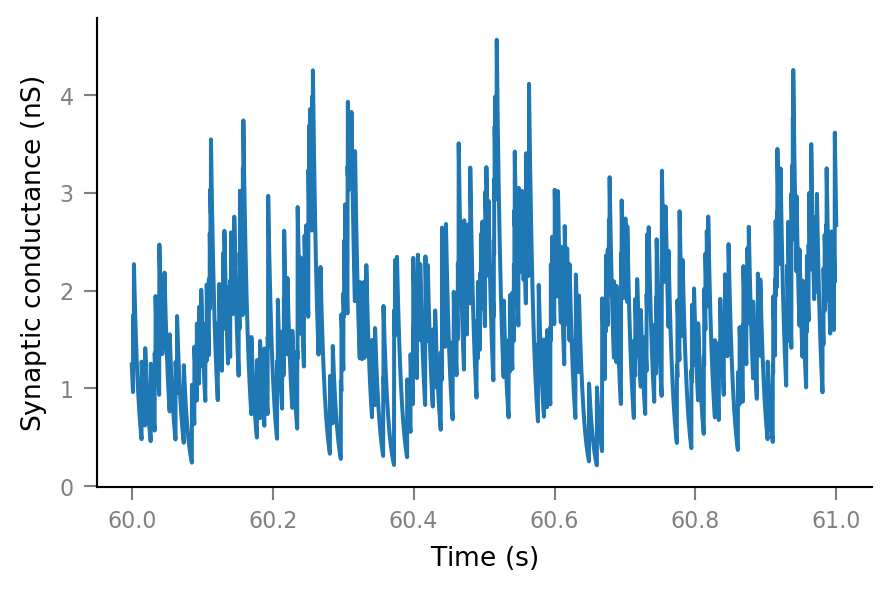
Membrane voltage¶
params = v.params.cortical_RS
print(params)
IzhikevichParams
----------------
C = 100 pF
k = 0.7 nS/mV
v_r = -60 mV
v_t = -40 mV
v_peak = 35 mV
a = 0.03 1/ms
b = -2 nS
c = -50 mV
d = 100 pA
v_syn = 0 mV
%%time
sim = v.simulate_izh_neuron(tg, params, g_syn)
Wall time: 1.05 s
plt.plot(t_slice, sim.V_m[i_slice]);
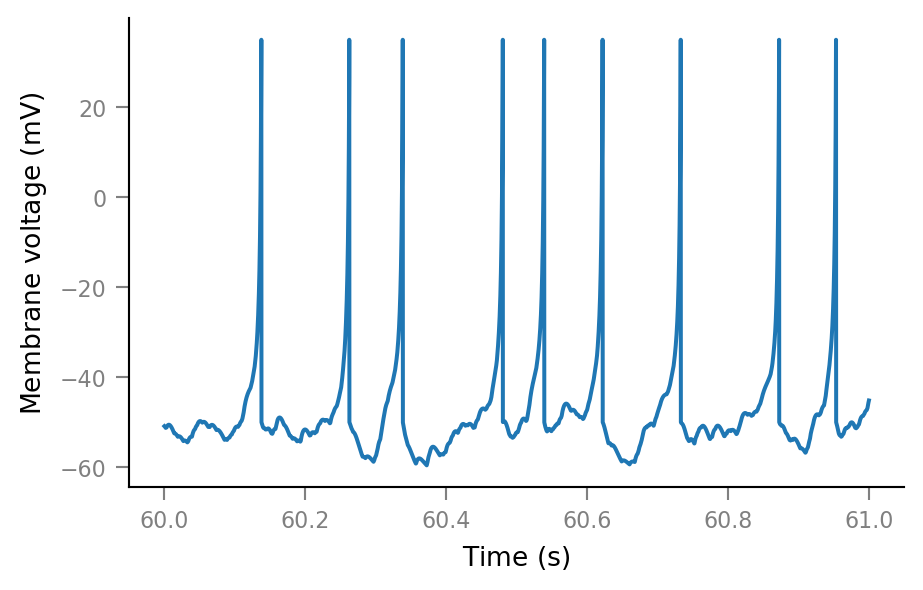
Noise¶
SNR = 10
spike_height = params.v_peak - params.v_r
σ_noise = spike_height / SNR
noise = np.random.randn(tg.N) * σ_noise
Vm_noisy = (sim.V_m + noise).in_units(mV)
Vm_noisy.name = "VI signal"
plt.plot(t_slice, Vm_noisy[i_slice]);
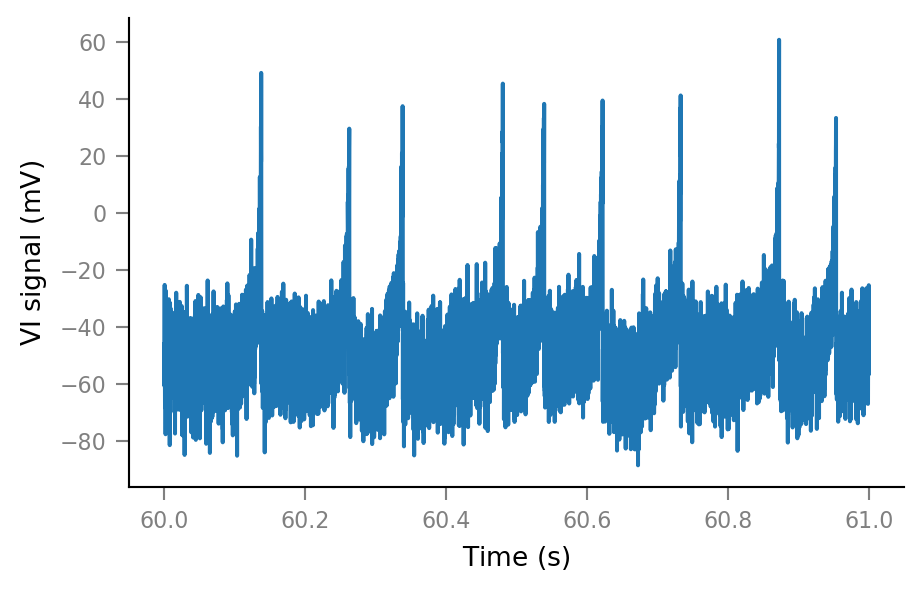
Clip spikes¶
import seaborn as sns
%%time
ax = sns.distplot(np.array(Vm_noisy.in_display_units))
ax.set_xlabel("VI signal (mV)");
Wall time: 41.8 s
Text(0.5, 0, 'VI signal (mV)')
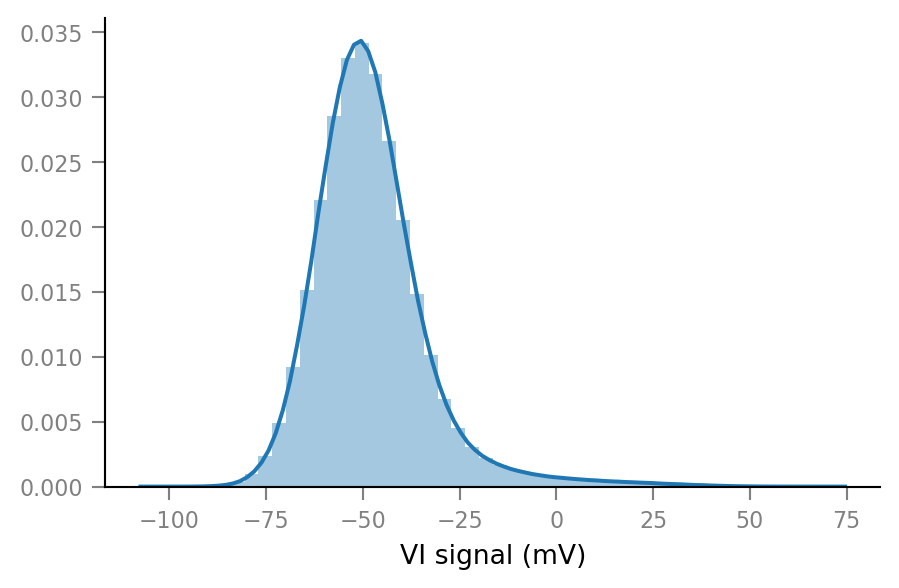
We’ll arbitrarily put a threshold here:
clip_threshold = -20 * mV;
Vm_noisy_clipped = np.clip(Vm_noisy, a_min=None, a_max= clip_threshold).in_units(mV);
fig, ax = plt.subplots()
ax.plot(t_slice, Vm_noisy[i_slice])
ax.plot(t_slice, Vm_noisy_clipped[i_slice]);
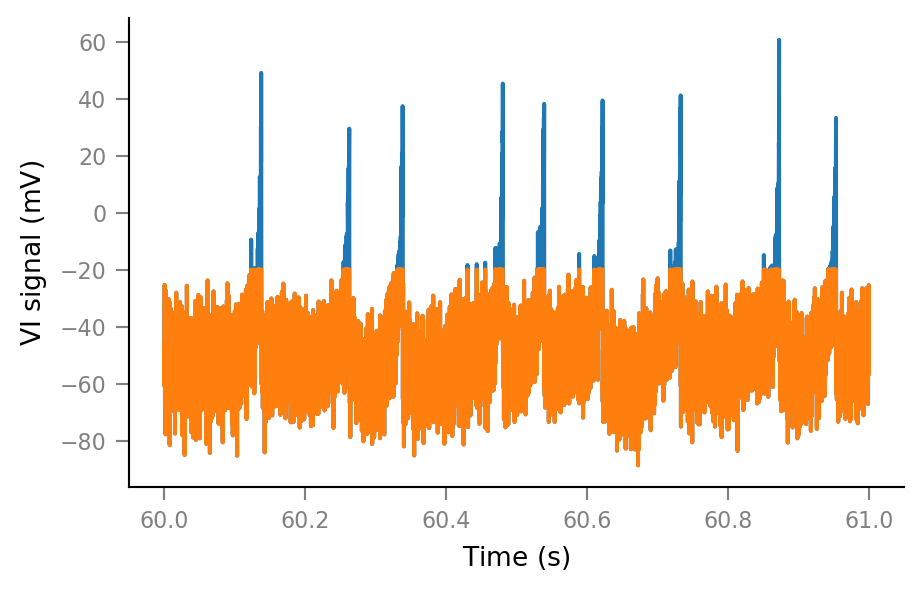
Spike-triggered windows¶
def get_spike_indices(spike_train):
# `nonzero` returns a tuple (one element for each array dimension).
(spike_indices,) = np.nonzero(spike_train)
return spike_indices
Extract windows from the VI signal.
window_length = 100 * ms
window_tg = v.TimeGrid(window_length, tg.dt)
window_tg.t.name = "Time after spike"
# Performance
Vm_noisy_clipped_arr = np.asarray(Vm_noisy_clipped)
window_tg_N = window_tg.N
tg_N = tg.N
import numba
@numba.njit
def _make_windows(spike_indices):
windows = []
for ix in spike_indices:
ix_end = ix + window_tg_N
if ix_end < tg_N:
windows.append(Vm_noisy_clipped_arr[ix:ix_end])
return windows
def make_windows(spike_indices):
windows = np.stack(_make_windows(spike_indices))
return Array(windows, V, name=Vm_noisy_clipped.name).in_units(mV)
spike_train__example = all_spike_trains[0]
spike_indices__example = get_spike_indices(spike_train__example)
windows__example = make_windows(spike_indices__example)
windows__example.shape
(12019, 1000)
An example spike-triggered window:
plt.plot(window_tg.t, windows__example[0, :]);
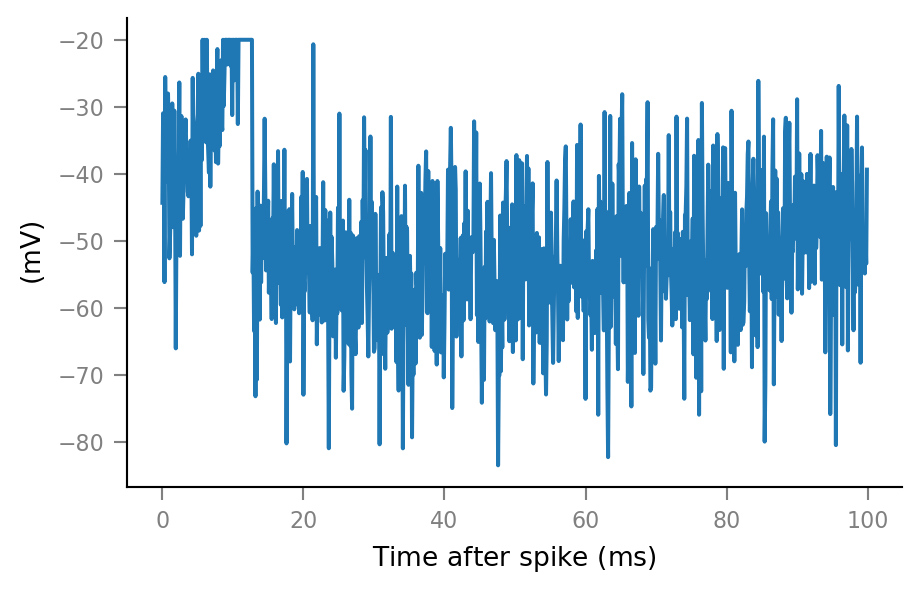
And some more:
fig, axes = plt.subplots(nrows=3, ncols=3, sharex=True, sharey=True)
for row, row_axes in enumerate(axes):
for col, ax in enumerate(row_axes):
i = 3 * row + col
ax.plot(window_tg.t, windows__example[i, :])
if not (row == 2 and col == 0):
ax.set(xlabel=None, ylabel=None)
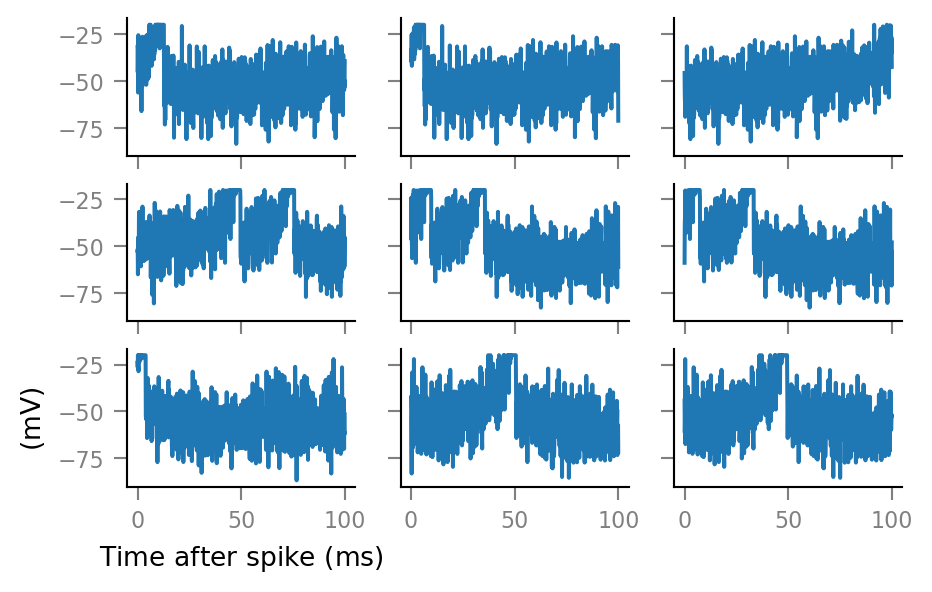
Average windows¶
def STA(spike_train):
spike_indices = get_spike_indices(spike_train)
windows = make_windows(spike_indices)
STA = windows.mean(axis=0)
return Array(STA, V, name="Spike-triggered <VI signal>").in_units(mV)
def plot_STA(spike_train, ax=None, **kwargs):
if ax is None:
fig, ax = plt.subplots()
ax.plot(window_tg.t, STA(spike_train), **kwargs)
plot_STA(spike_trains_connected[0])
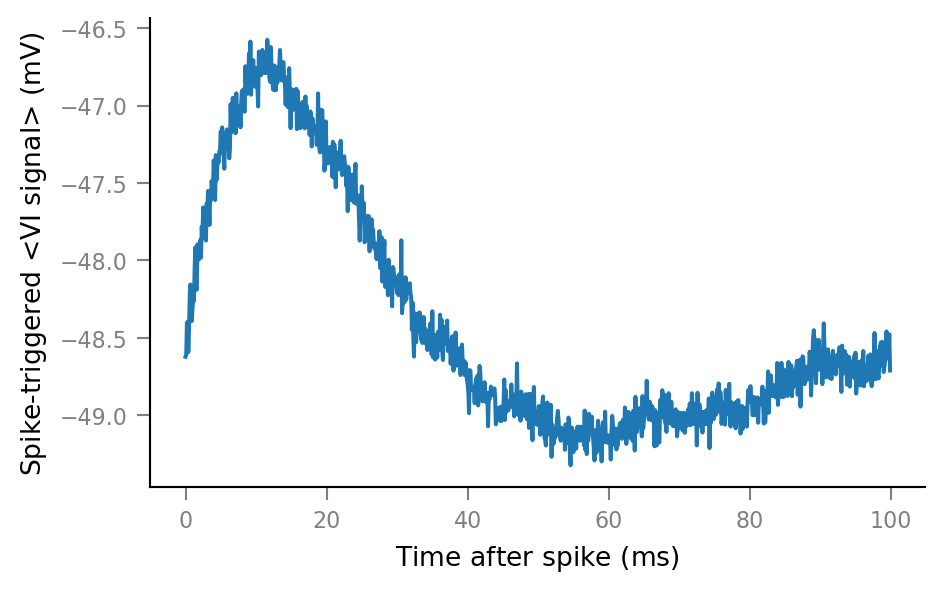
plot_STA(spike_trains_unconnected[0])
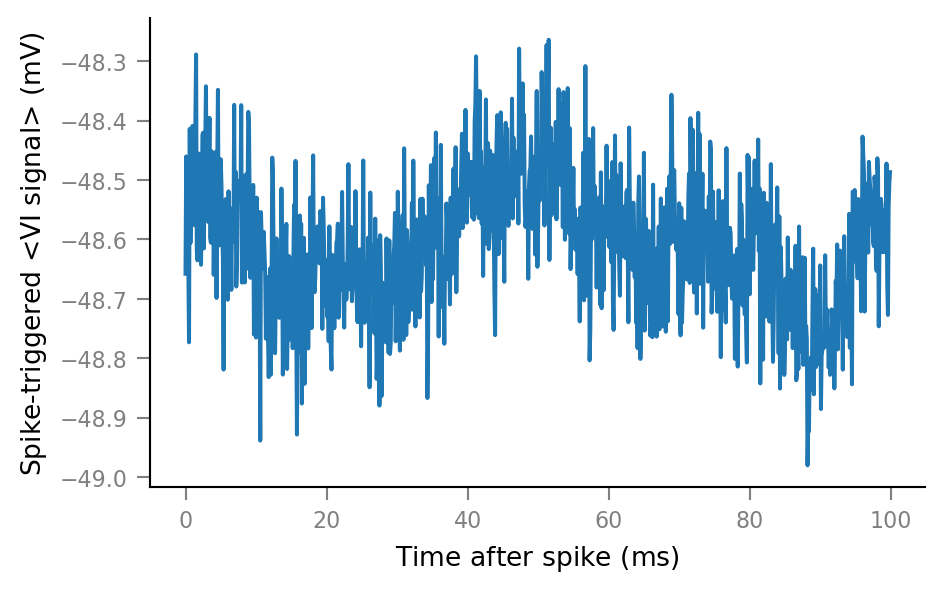
Plot STAs of all spike trains¶
%%time
fig, ax = plt.subplots()
for spike_train in spike_trains_connected:
plot_STA(spike_train, ax, alpha=0.2, color='C0')
for spike_train in spike_trains_unconnected:
plot_STA(spike_train, ax, alpha=0.2, color='C1')
plt.close()
Wall time: 31.9 s
# Clear existing texts, for iterative positioning.
for _ in range(len(ax.texts)):
ax.texts.pop()
ax.annotate(
"Spikes from\nconnected neurons",
xy=(26.55 * ms, 0.8),
xycoords=("data", "axes fraction"),
color="C0",
ha="left",
)
ax.annotate(
"Spikes from\nunconnected neurons",
xy=(70 * ms, 0.5),
xycoords=("data", "axes fraction"),
color="C1",
ha="center",
)
fig
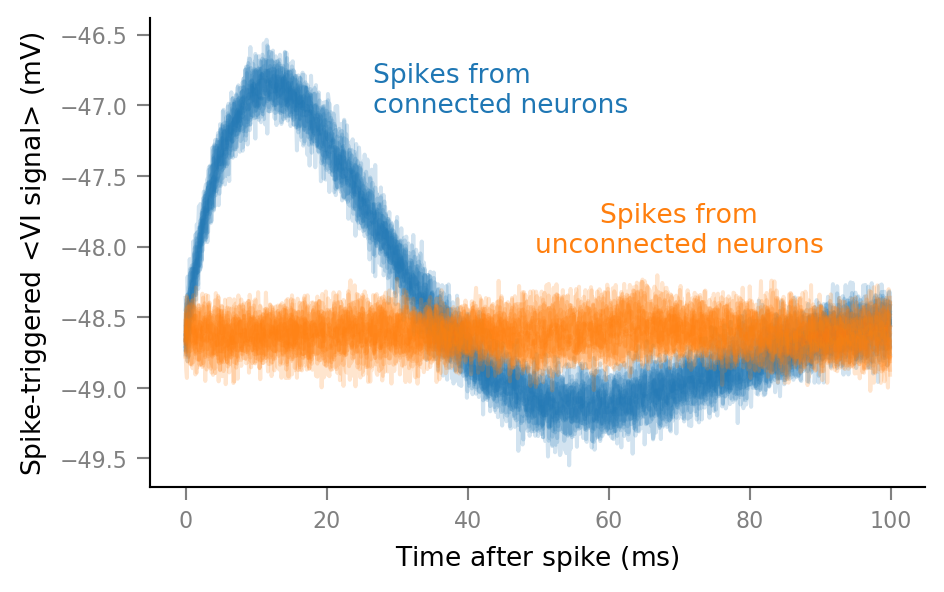
This was the first STAs plot, with unclipped spikes (and also with τ_syn = 7 ms):
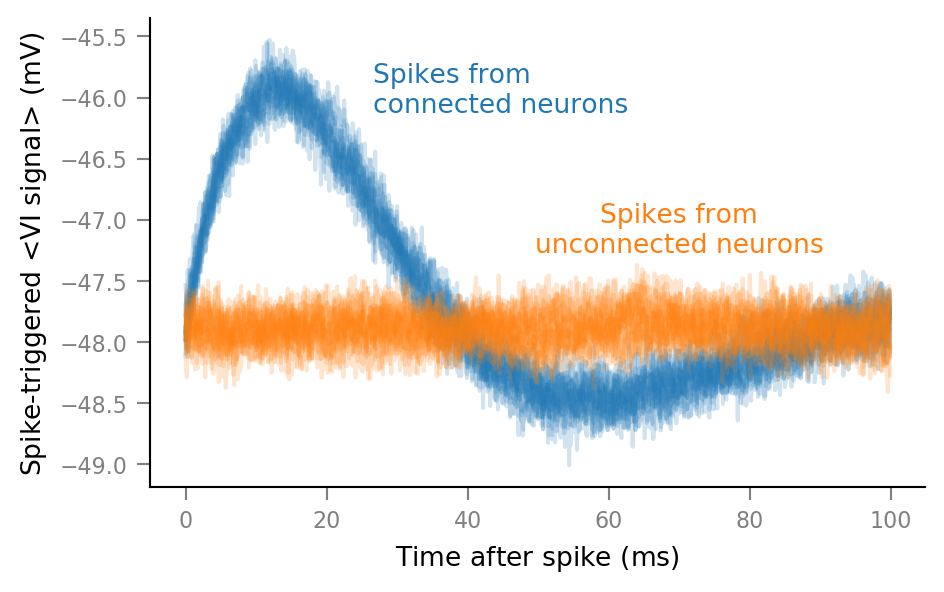
Next steps:
calculate p(connected) for every presynaptic neuron
describe influence of
N_in,p_connected,SNR, ..VI realism